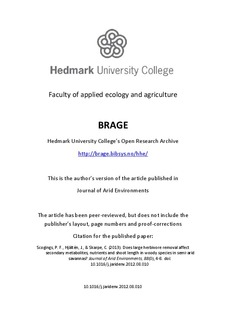| dc.contributor.author | Scogings, Peter F. | |
| dc.contributor.author | Hjältén, Joachim | |
| dc.contributor.author | Skarpe, Christina | |
| dc.date.accessioned | 2012-10-26T08:22:53Z | |
| dc.date.available | 2012-10-26T08:22:53Z | |
| dc.date.issued | 2013 | |
| dc.identifier.citation | Scogings, P. F., Hjältén, J., & Skarpe, C. (2013). Does large herbivore removal affect secondary metabolites, nutrients and shoot length in woody species in semi-arid savannas? Journal of Arid Environments, 88(0), 4-8. doi: 10.1016/j.jaridenv.2012.08.010 | no_NO |
| dc.identifier.uri | http://hdl.handle.net/11250/134488 | |
| dc.description | This is the postprint version of the article published in Journal of Arid Environment. The published article can be located here: http://www.sciencedirect.com/science/article/pii/S0140196312002364 | no_NO |
| dc.description.abstract | We hypothesised that exclusion of long-term browsing leads to decreased nutrient concentrations, increased carbon-based secondary metabolites (CBSMs) and decreased shoot length in woody plants in semi-arid savannas. To test this, we sampled four deciduous woody species in a large-scale, long-term exclusion experiment. We found a tendency for large herbivore exclusion to either decrease nitrogen or increase tannin in two tree species. Phosphorus and total polyphenol responses indicated complex interactions with herbivore assemblage. Shoot length decreased under exclusion in two species, while a similar tendency existed in the remaining species. Therefore, we found limited support for our predictions that exclusion of browsing results in reduced nitrogen or increased CBSMs, but moderate support for decreased shoot length in semi-arid savannas. Dichrostachys cinerea, a fast-growing, aggressive invader in savannas, displayed C-limitation with removal of large herbivores because both shoot length and CBSMs decreased. In conclusion, effects of long-term browsing on deciduous trees in semi-arid savannas depend on the plant species, specific nutrients or CBSMs measured and the composition of the herbivore assemblages. Because elephant densities in the study area were high and most responses were associated with their exclusion, we conclude that elephants are important drivers of browse quality in the study area. | no_NO |
| dc.language.iso | eng | no_NO |
| dc.publisher | Elsevier | no_NO |
| dc.subject | elephant | no_NO |
| dc.subject | exclusion experiment | no_NO |
| dc.subject | nitrogen | no_NO |
| dc.subject | phenol | no_NO |
| dc.subject | plant defence | no_NO |
| dc.subject | tannin | no_NO |
| dc.title | Does large herbivore removal affect secondary metabolites, nutrients and shoot length in woody species in semi-arid savannas? | no_NO |
| dc.type | Journal article | no_NO |
| dc.type | Peer reviewed | no_NO |
| dc.subject.nsi | VDP::Mathematics and natural science: 400::Zoology and botany: 480 | no_NO |
| dc.source.pagenumber | 4-8 | no_NO |
| dc.source.volume | 88 | no_NO |
| dc.source.journal | Journal of Arid Environments | no_NO |
